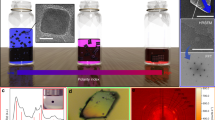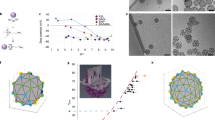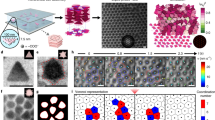Abstract
Systems far from equilibrium can exhibit complex transitory structures, even when equilibrium fluctuations are mundane1,2. A dramatic example of this phenomenon has recently been demonstrated for thin-film solutions of passivated nanocrystals during the irreversible evaporation of the solvent3,4,5,6,7,8,9,10,11,12,13,14. The relatively weak attractions between nanocrystals, which are efficiently screened in solution, become manifest as the solvent evaporates, initiating assembly of intricate, slowly evolving structures4. Although certain aspects of this aggregation process can be explained using thermodynamic arguments alone6, it is in principle a non-equilibrium process7. A representation of this process as arising from the phase separation between a dense nanocrystal ‘liquid’ and dilute nanocrystal ‘vapour’ captures some of the behaviour observed in experiments3, but neglects entirely the role of solvent fluctuations, which can be considerable on the nanometre length scale15. Here we present a coarse-grained model of nanoparticle self-assembly that explicitly includes the dynamics of the evaporating solvent. Simulations using this model not only account for all observed spatial and temporal patterns, but also predict network structures that have yet to be explored. Two distinct mechanisms of ordering emerge, corresponding to the homogeneous and heterogeneous limits of evaporation dynamics. Our calculations show how different choices of solvent, nanoparticle size (and identity) and thermodynamic state give rise to the various morphologies of the final structures. The resulting guide for designing statistically patterned arrays of nanoparticles suggests the possibility of fabricating spontaneously organized nanoscale devices.
This is a preview of subscription content, access via your institution
Access options
Subscribe to this journal
Receive 51 print issues and online access
$199.00 per year
only $3.90 per issue
Buy this article
- Purchase on Springer Link
- Instant access to full article PDF
Prices may be subject to local taxes which are calculated during checkout




Similar content being viewed by others
References
Bray, A. J. Theory of phase-ordering kinetics. Adv. Phys. 43, 357–459 (1994)
Tanaka, H. Viscoelastic phase separation. J. Phys. Condens. Matter 12, R207–R264 (2000)
Ge, G. & Brus, L. E. Evidence for spinodal phase in two-dimensional nanocrystal self-assembly. J. Phys. Chem. B 104, 9573–9575 (2000)
Tang, J., Ge, G. & Brus, L. E. Gas-liquid-solid phase transition model for two-dimensional nanocrystal self-assembly on graphite. J. Phys. Chem. B 106, 5653–5658 (2002)
Puntes, V. F., Krishnan, K. M. & Alivisatos, A. P. Colloidal nanocrystal shape and size control: The case of cobalt. Science 291, 2115–2117 (2001)
Gelbart, W. M., Sear, R. P., Heath, J. R. & Chaney, S. Array formation in nano-colloids: Theory and experiment in 2D. Farad. Disc. 112, 299–307 (1999)
Whitesides, G. M. & Grzybowski, B. Self-assembly at all scales. Science 295, 2418–2421 (2002)
Murray, C. B., Kagan, C. R. & Bawendi, M. G. Self-organization of CdSe nanocrystallites into 3-dimensional quantum-dot superlattices. Science 270, 1335–1338 (1995)
Freeman, R. G. et al. Self-assembled metal colloid monolayers—an approach to SERS substrates. Science 267, 1629–1632 (1995)
Andres, R. P. et al. Self-assembly of a two-dimensional superlattice of molecularly linked metal clusters. Science 273, 1690–1693 (1996)
Harfenist, S. A., Wang, Z. L., Alvarez, M. M., Vezmar, I. & Whetten, R. L. Highly oriented molecular Ag nanocrystal arrays. J. Phys. Chem. 100, 13904–13910 (1996)
Sear, R. P., Chung, S. W., Markovich, G., Gelbart, W. M. & Heath, J. R. Spontaneous patterning of quantum dots at the air-water interface. Phys. Rev. E 59, R6255–R6258 (1999)
Fried, T., Shemer, G. & Markovich, G. Ordered two-dimensional arrays of ferrite nanoparticles. Adv. Mater. 13, 1158–1161 (2001)
Redl, F. X., Cho, K. S., Murray, C. B. & O'Brien, S. Three-dimensional binary superlattices of magnetic nanocrystals and semiconductor quantum dots. Nature 423, 968–971 (2003)
Elbaum, M. & Lipson, S. G. How does a thin wetted film dry up? Phys. Rev. Lett. 72, 3562–3565 (1994)
Chandler, D. Introduction to Modern Statistical Mechanics (Oxford Univ. Press, New York, 1987)
Ge, G. & Brus, L. E. Fast surface diffusion of large disk-shaped nanocrystal aggregates. Nano Lett. 1, 219–222 (2001)
Lo, A. & Skoodje, R. T. Kinetic and Monte Carlo models of thin film coarsening: Cross over from diffusion-coalescence to Ostwald growth modes. J. Chem. Phys. 112, 1966–1974 (2000)
Maillard, M., Motte, L., Ngo, A. T. & Pileni, M. P. Rings and hexagons made of nanocrystals: A Marangoni effect. J. Phys. Chem. B 104, 11871–11877 (2000)
Witten, T. A. & Sander, L. M. Diffusion-limited aggregation, a kinetic critical phenomenon. Phys. Rev. Lett. 47, 1400–1403 (1981)
Stowell, C. & Korgel, B. A. Self-assembled honeycomb networks of gold nanocrystals. Nano Lett. 1, 595–600 (2001)
Acknowledgements
This work was supported by the United States–Israel Binational Science Foundation. L.E.B. is supported by the Columbia MRSEC. P.L.G. was an MIT Science Fellow throughout most of this work. D.R.R. is a Sloan Fellow and Camille Dreyfus Teacher-Scholar.
Author information
Authors and Affiliations
Corresponding authors
Ethics declarations
Competing interests
The authors declare that they have no competing financial interests.
Supplementary information
Rights and permissions
About this article
Cite this article
Rabani, E., Reichman, D., Geissler, P. et al. Drying-mediated self-assembly of nanoparticles. Nature 426, 271–274 (2003). https://doi.org/10.1038/nature02087
Received:
Accepted:
Issue Date:
DOI: https://doi.org/10.1038/nature02087
This article is cited by
-
Modeling nanoparticle agglomeration in the centrifugal method to evaluate heat-resistant functionally graded materials
Journal of Nanoparticle Research (2023)
-
Self-assembly of highly ordered micro- and nanoparticle deposits
Nature Communications (2022)
-
Cooperative excitonic quantum ensemble in perovskite-assembly superlattice microcavities
Nature Communications (2020)
-
Drying-Mediated Self-Assembly of Graphene for Inkjet Printing of High-Rate Micro-supercapacitors
Nano-Micro Letters (2020)
-
In-situ liquid-cell TEM study of radial flow-guided motion of octahedral Au nanoparticles and nanoparticle clusters
Nano Research (2018)
Comments
By submitting a comment you agree to abide by our Terms and Community Guidelines. If you find something abusive or that does not comply with our terms or guidelines please flag it as inappropriate.



